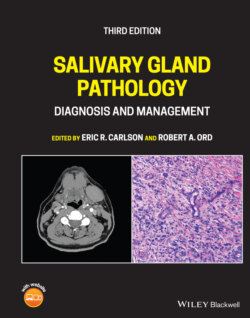Читать книгу Salivary Gland Pathology - Группа авторов - Страница 93
SJÖGREN SYNDROME
ОглавлениеThis autoimmune disease affects the salivary glands and lacrimal glands and is designated primary Sjogren if no systemic connective tissue disease is present but designated secondary Sjogren if the salivary disease is associated with systemic connective tissue disease (Madani and Beale 2006a). The presentations vary radiographically according to stage. Typically, early in the disease the gland may appear normal on CT and MRI. Early during the disease, there may be premature fat deposition, which may be demonstrated radiographically and may be correlated with abnormal salivary flow (Izumi et al. 1997). Also, in the early course of disease, tiny cysts may form consistent with dilated acinar ducts and either enlarge or coalesce as the disease progresses. These can give a mixed density appearance of the gland with focal areas of increased and decreased density by CT and areas of increased and decreased signal on T1 and T2 MRI, giving a “salt and pepper” appearance (Takashima et al. 1991, 1992). There may be either diffuse glandular swelling from the inflammatory reaction or this may present as a focal area of swelling. The diffuse swelling may mimic viral or bacterial sialadenitis. The focal swelling may mimic a tumor, benign or malignant, including lymphoma. Pseudotumors may be cystic lesions from coalescence or formation of cysts or dilatation of ducts, or they may be solid from lymphocytic infiltrates (Takashima et al. 1991, 1992). As glandular enlargement and cellular infiltration replaces the fatty elements, the gland appears denser on CT and lower in signal on T1 and T2 MRI. But when chronic inflammatory changes have progressed, tiny or course calcifications may develop. The cysts are variable in size, and the larger cysts may represent confluent small cysts or abscesses. The CT and MRI appearance can be like that of lymphoepithelial lesions seen with HIV but does include calcifications. Typically, there is no diffuse cervical lymphadenopathy. The development of cervical adenopathy may indicate development of lymphoma (Takashima et al. 1992). Solid nodules or masses can also represent underlying lymphoma (non‐Hodgkin type) to which these patients are prone (Sugai 2002). The latter stages of the disease produce a smaller and more fibrotic gland (Shah 2002; Bialek et al. 2006; Madani and Beale 2006a).
Figure 2.56. Reformatted coronal contrast‐enhanced CT of the submandibular gland demonstrating a sialolith in the hilum of the right submandibular gland.
Figure 2.57. Axial contrast‐enhanced CT of the parotid gland demonstrating a small left parotid sialolith (arrow).
Figure 2.58. Axial contrast‐enhanced CT at the level of the submandibular glands with a very large left hilum sialolith (arrow).
